How do you engage stakeholders such as regulators, customers and suppliers to drive your environmental strategy? What role does stakeholder feedback play in shaping your approach?
: “Engaging our stakeholders is the focal point of our CSR strategy and our ResponsibleSteel® approach. Back in 2018 we built an initial materiality matrix based on interviews with our stakeholders. This is our compass for setting the priorities validated by our Sustainable Development Committee, the governance body set up in 2015 to steer our CSR actions. We updated it at the beginning of 2024, with more than 40 interviews conducted by an independent body with representatives of the nine stakeholder families we have identified.”
“A concrete example of how we integrate stakeholders into our action plans? Twice a year, at each of our sites in Belval, Rodange, Differdange and Sanem, we organise meetings with representatives of local authorities, local residents and inspection bodies, to take stock of their expectations and demands, our industrial initiatives and our environmental projects. These are opportunities for frank and transparent discussion! And on the regulatory side, we contribute to Fedil and Chamber of Commerce working groups on European directives.”
What are the unique challenges and opportunities you face in implementing ecological and environmental transitions within your industry?
“The global steel industry accounts for around 7% of greenhouse gas emissions. The ArcelorMittal Group has set itself the ambitious target of reducing itsCO2 emissions in Europe by 35% by 2030 (compared with 2018), and being carbon neutral by 2050.”
“To achieve this, we need to bring about a real technological revolution!”
“Our approach is to use a combination of solutions. Firstly, we are going to gradually replace our blast furnaces with electric furnaces, in which we will mainly melt scrap and pre-reduced iron ore to obtain steel grades comparable to those of the blast furnace route. We will also be relying on ‘Smart Carbon’ solutions, which involve reinjecting the CO2 generated by the production process into the blast furnaces or capturing and storing it. Finally, direct electrolysis is a promising innovative technology for decarbonising steel.”
Looking ahead, what emerging trends or developments do you foresee that could influence your sector's approach to environmental sustainability, and how are you preparing for these changes?
“Steel is often singled out because of the environmental impact of its production processes. And the world's need for steel is only going to increase, because steel production follows the growth curve of the world’s population, and by 2050 there will be almost 10 billion people on the planet! The good news is that steel is part of the solution for deploying a low-carbon economy: renewable energy infrastructures (wind turbines), lighter electric vehicles, more energy-efficient buildings that consume fewer finite resources. ArcelorMittal is a forerunner in decarbonisation.”
“We have clearly identified where to act, and we know how to do it. We are at the forefront of offering low-carbon steel solutions with our revolutionary XCarb® brand, now supported by a growing range of environmental product declarations (EPDs), mainly for the construction sector. We therefore have the strengths to make our steels part of the decarbonised economy of the future.”
